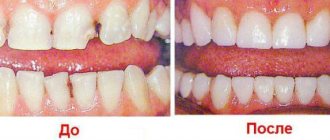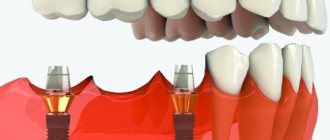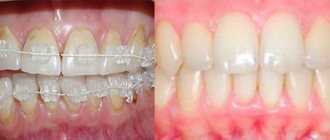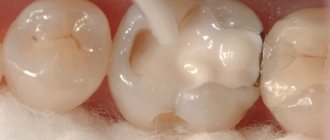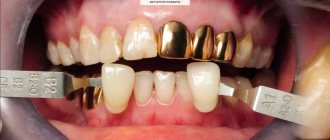As you know, most species of sharks completely change their teeth several times during their lives, and some of these dangerous predators manage to do this every few weeks. A person lives with one “set” all his life. At the same time, poor ecology, poor oral hygiene, unhealthy food, caries and other dental diseases do their job - they destroy our teeth. Fortunately, modern dentistry has a whole arsenal of tools for their restoration. Which ones exactly - says the chief physician, therapist and esthetician of the AktivStom clinic in Moscow, Yana Valentinovna Fedorova.
Teeth extension methods
Modern dentistry offers various methods and technologies for teeth extension. The choice of method depends on the patient’s financial capabilities and indications. Repairing a badly broken tooth will require such a drastic decision as installing a crown. A small chip can be corrected using composite materials. If a tooth has lost around 10–20% of tissue, then this is an indication for the installation of indirect ceramic veneers (provided that the patient does not suffer from tooth wear).
Teeth extension using composite materials
Modern filling materials used for the restoration of front teeth harden only under the influence of the rays of a special lamp, most often an ultraviolet one. This gives the specialist the opportunity to carefully restore the natural shape of the damaged tooth. This is especially important when reconstructing large chips. However, after curing, the composite material becomes no less durable than a natural tooth, and if the doctor follows all standards and protocols, the junction of the enamel and the composite will not only be invisible, but also reliable - the tooth restored in this way will last for many years. However, it should be remembered that such restorations still have a service life and after 7 to 10 years they may require replacement.
How is front teeth augmentation done?
The front teeth are quite often subject to mechanical damage - chips and cracks form on them, and as a result of injuries, a significant part of the tooth can even break off. Also, the front teeth are susceptible to wear; if the problem is aggravated by a direct bite, then the wear becomes pathological. A special type of wear on the front incisors is horseshoe-shaped, which is often found among those who like to chew seeds. In addition, a common problem is gaps between the front teeth. In most such cases, functionality and aesthetics can be restored with the help of tooth augmentation with composite materials.
Another way to correct teeth in the smile area is to build teeth using veneers. These are thin plates attached to the front surface of the teeth. They perfectly imitate natural enamel in color and transparency, and do not add excessive thickness to the teeth. Veneers can be composite (made by a doctor directly in the patient’s mouth) and ceramic (made in a dental laboratory and glued to the teeth using special cement). This method of restoration is suitable in cases of thinning enamel, microcracks, and small chips. Also, extensions using ceramic and composite veneers help get rid of gaps between teeth - diastemas and threes, in cases where you can do without orthodontic treatment.
Causes of tooth enamel destruction
Despite its high strength, enamel tends to deteriorate, which jeopardizes the health of teeth and oral cavity. It is necessary to identify the cause of destruction in time and take action - then it will be possible to slow down the process and the process of restoring the enamel using simple means will be available.
Poor nutrition
The most common cause of not only the destruction of tooth enamel, but also the appearance of diseases of the gums and oral cavity in general.
Negatively affects tooth enamel:
- Sudden changes in the temperature of food consumed (for example, drinking coffee and eating frozen foods).
- Frequent consumption of frozen vegetables and processed foods can cause digestive problems, which will certainly affect the health of tooth enamel.
- Lack of vitamins (for example, due to a strict vegetarian diet)
- Frequent consumption of carbonated drinks and sweets slowly destroys the enamel.
- Too sour and spicy foods also negatively affect enamel.
These are the most common reasons that relate to poor diet. If it turns out that there is a lack of vitamins in the body, you need to immediately start taking vitamin complexes, and then restore tooth enamel.
Caries
Caries is the main cause of enamel destruction throughout a person’s life. At first, caries does not cause any inconvenience, but in fact, the process of destruction of enamel begins immediately after the appearance of caries. The sooner you address this issue, the easier it will be to restore the enamel.
As a rule, the initial stage of caries development is accompanied by a change in the color of the teeth and the appearance of specific stains.
The next stage destroys tooth enamel more significantly and restoration becomes more difficult. Increased tooth sensitivity to: lemon, apple, sweets and other aggressive foods. Noticeable pigmentation appears, the enamel is damaged by the action of cariogenic bacteria and turns dark brown. Painful sensations are either rare or absent (but the destruction of enamel increases).
Deep caries is the last stage of development, accompanied by pain from eating and brushing teeth. At this stage, enamel restoration becomes a very problematic process and most home methods will no longer help. It is necessary to treat caries and then restore the enamel using professional means and methods in a dental clinic.
Bad habits - smoking and alcohol abuse
Smoking very quickly destroys tooth enamel as two destructive factors act simultaneously - temperature and bacterial. It greatly contributes to the development of caries, which in turn accelerates the destruction of enamel and deterioration of dental health.
Alcohol is not as harmful as smoking, but if abused, calcium and magnesium are washed out of the body , which subsequently leads to the destruction of enamel due to a lack of these elements. The result of the effect of alcohol on teeth is a change in the composition of saliva to a more aggressive one (acid-base). Rapid demineralization of dentin and tooth crowns occurs. Insufficient production of salivary fluid reduces the strength of the enamel and further exposes it to abrasion.
Chronic diseases
Chronic diseases have an extremely negative impact on dental health , including surface enamel. The most common chronic diseases that lead to rapid destruction of tooth enamel:
- Hypertension - contributes to the development of caries and the regular appearance of plaque on the teeth. This happens due to a significant decrease in the performance of the salivary glands (little saliva is produced and it ceases to protect the oral cavity at the required level).
- Increased acidity in the stomach (Gastritis). The negative effect on enamel is expressed in a decrease in the body's absorption of phosphorus and calcium (which are necessary for the health of enamel and teeth in general).
- Diabetes mellitus also leads to a lack of essential enamel minerals.
- Metabolic disorders and improper functioning of the thyroid gland lead to rapid destruction from a lack of vitamins and minerals.
- Taking antibiotics affects the entire body , and teeth are no exception. A recovery period is necessary to strengthen the enamel and immunity.
Malocclusions
Incorrect bite causes gradual destruction of the enamel mechanically , namely in the process of abrasion of layers as a result of strong pressure. When teeth do not fit well together due to unevenness, part of the enamel can break off and bacteria can penetrate inside the tooth. It is necessary to immediately contact a dentist and prevent all further mechanical damage.
An incorrect bite cannot be left without correction, since the enamel will quickly wear off and dentures and implants will have to be used to restore teeth. Some people have developed the habit of clenching their teeth tightly and this greatly damages the enamel. It also negatively affects certain areas of tooth enamel.
Poor oral hygiene
When a person stops devoting time to oral hygiene and dental care, caries and other diseases appear. The longer this continues, the more irreversible the process of tooth decay becomes.
If you notice plaque on your teeth (in large quantities), you need to remove it as quickly as possible, for example, with professional teeth cleaning at a dental clinic.
There are also many means and tools for maintaining the health of tooth enamel at a high level. It is better to immediately get used to using professional toothpastes, gels and rinses, if possible. To prevent caries and periodontitis, use professional irrigators.
Teeth extension with photopolymer
Another feature of composite materials that should not be forgotten is the degree of porosity, which exceeds the porosity of natural enamel. For the patient, this means two things: firstly, in the first few days after augmenting the front teeth with composite materials, you should refrain from consuming coloring foods and drinks, and every six months, when visiting a professional hygiene procedure, you need to pay special attention to the restorations, including the hygienist should polish them thoroughly. As for the external difference between the augmented areas of teeth and natural ones, thanks to modern methods for producing composites, the dentist has the opportunity to choose the color of the restoration to match the color of the patient’s enamel.
Benefits of restoration
The most important advantage of restoration compared to prosthetics is the absence of pain and surgical intervention. There is no need to cut the gum, build up the bone tissue of the tooth, or wait a long time for the material to engraft. It is possible to restore a tooth even if the crown is completely lost. During one visit to an orthopedic dentist, several incisors can be restored.
The cost of the procedure is much lower than the cost of installing a prosthesis. The service life of composite materials is about seven years. In the future, you can update the extended tooth using the same method. An important advantage of restoration is the ability to restore teeth in hard-to-reach places.
Are there any disadvantages to this method? The main disadvantage is the operating time. If you treat new teeth with care, the composite can last a long time - up to ten years. If you are not careful, the accumulated mass can become deformed within a year. You can no longer eat solid food, and you should also get rid of some habits.
Rules of care
How to brush new teeth, with what toothpastes? In the first days after the procedure, you should refrain from foods and drinks that can stain the surface of the crown. In the future, oral care does not differ from usual. However, patients need to visit their doctor regularly for preventive examinations.
Self-build
Is it possible to build up the missing part of a tooth yourself at home? Unfortunately, this is impossible, just as it is impossible to fill a tooth yourself. However, at home you can strengthen the enamel if it is partially lost or severely abraded. To do this, a remineralization procedure is carried out with special compounds prescribed by the dentist.
Compositions for remineralization:
- special pastes;
- application of aligners and wax matrices;
- protection of enamel with dental varnishes.
Professional dental treatment is also carried out in clinics.
Extension of chewing teeth
Chewing teeth are also often subject to destruction, in most cases the cause is caries. After treatment of caries, especially deep ones, large cavities remain, which the specialist fills with filling material after treatment. However, in some cases, only the root and a few thin walls may remain from the tooth, and sometimes even these remain. However, one of the trends in modern dentistry is the use of maximally tooth-preserving techniques. Therefore, if previously a healthy root that had lost its coronal part would most likely have been removed and a bridge-like prosthesis installed instead of the tooth, or, at best, an implant, today they prefer to preserve the root and restore the coronal part by installing an inlay and a crown.
What is a pin
In modern dentistry, various designs are used to recreate damaged teeth.
A pin is one such structure that serves as a support for filling material or a crown. The pin is installed in the root cavity after the nerve is removed. Thanks to this procedure, it is possible to preserve the root, dentition and original structure of the jaw.
The main task of the pin, which is installed on a pulpless tooth, is to evenly distribute chewing pressure. Thus, when chewing, parts of the restored tooth will not experience increased pressure and will not be damaged.
Tooth extension onto a pin
Some dentists still carry out tooth augmentation on a pin, which involves installing a metal rod (pin) directly into the root canal and layer-by-layer application of composite materials on it. Once upon a time, this method was a real breakthrough compared to conventional filling, as it made it possible to preserve the root and completely restore the tooth, even in cases where the coronal part was completely lost. However, subsequently, caries often formed around the pin, which provoked further tooth destruction and loss. Therefore, pins are a thing of the past, giving way to more reliable methods.
Correction with crowns
The installation of crowns as tooth extensions is also used in cases where the tooth is not destroyed, but is sufficiently damaged. Installing a crown is one of the effective ways to restore a broken tooth, this applies to both front and chewing teeth. Crowns are also used in cases where it is not possible to fill a chewing tooth, for example, because the cavity left after caries treatment is too large. This type of permanent prosthetics, such as crowns, is an ideal solution in cases where more than 70% of the crown part of the tooth is missing.
In modern aesthetic dentistry, ceramic and metal-ceramic crowns are successfully used. The installation process itself takes place in two stages. First, the doctor prepares the tooth (removes infected tissue, grinds down the walls), then an impression is taken, from which a crown for a chewing tooth or a crown for a front tooth is made in a dental laboratory. The second stage is the fitting and installation of the finished crown. Modern ceramics, used for the manufacture of inlays and crowns, make it possible to perfectly imitate the texture, color and transparency of natural enamel, as well as select a shade in accordance with the color of neighboring teeth.
Indications and contraindications
Depending on the chosen method of teeth extension, indications and contraindications for each specific technique should be determined by your dentist. In this situation, you should not be guided solely by your taste preferences. Otherwise, your uncompromising demand: “I want veneers!” may lead to the fact that the treatment will not bring the desired effect, and the money will be wasted. Don't forget: everything is individual. For example, extensions using photopolymers are not practiced if there is severe tooth mobility. It is also recommended to avoid veneering for those patients who suffer from periodontal disease or do not have the necessary dental hygiene skills.
Main indications for extensions
- Cracks and chips
Microdamages caused by trauma. - Damage to the crown
If the dental crown is deformed or broken. - Consequences of caries
In case of advanced caries, when the tooth root is intact, but the area for filling is too large. - Gaps between teeth
Diastema, which negatively affects aesthetics. - Changing the color of the enamel A
dental defect such as fluorosis - white spots on the surface of the tooth enamel - cannot be eliminated with whitening, but can be corrected with extensions. - Increased tooth abrasion
As a result of demineralization of tooth enamel or a hereditary factor. - Malocclusion
Effective for mild defects in the occlusion of the dentition.
Absolute contraindications to extensions
- Maximum damage to the tooth
If the tooth is destroyed by more than 30%, the extension will not give a positive result. - Allergy
An allergic reaction to individual components of filling materials is rare, but its presence makes extension impossible. - Bruxism
Night and daytime teeth grinding will definitely lead to the destruction of the extended tooth. - Unsuccessful tooth localization
If the tooth is located in such a way that it cannot be isolated from saliva during the procedure, which neutralizes its result.
Make an appointment
right now!
Fedorova Yana Valentinovna
Therapist, Hygienist
Why and when is extension needed?
The technique involves using dental material to fill in the missing area of the tooth. Based on this, extension is necessary in cases where there are corresponding defects. In this case, the technique will be effective both with minimal tooth abrasion and with significant destruction.
Main indications for extensions
Indications for extension are the following factors:
- Tooth decay due to various pathological processes, caries, traumatic injury;
- The need to correct any natural anomalies, including large gaps between teeth;
- Increased tooth wear;
- Unsatisfactory tooth size;
- Deterioration in tooth aesthetics due to fluorosis, when white spots on the tooth surface can only be corrected using this technique.
All these factors predispose a child to undergo tooth augmentation. Due to the mobility of children and frequent injuries, dentists most often have to build up their front teeth.
Extension techniques
There are several methods of teeth extension. Their choice is determined by the clinical situation and financial capabilities of the patient. Teeth extension using photopolymers is one of the most popular techniques. It is based on the unique properties of the material, its ability to harden only when exposed to light radiation. This allows the specialist to carry out all manipulations clearly and slowly. In addition to strength, complete restoration of aesthetic characteristics is ensured. Artificial fragments look the same as natural dental tissue. In addition, it will be possible to grow a tooth quickly and without harm to the enamel.
Extension using pins is a less preferable method, since the reliability of such a tooth is lower. However, since the procedure avoids tooth extraction and implantation, it also has every chance of being used. It involves installing a pin into the root canal of the tooth, placing a composite material around it and giving it the necessary shape.
An even more effective method is to preserve the tooth by installing an inlay, manufactured in a dental laboratory in accordance with the specified characteristics. This procedure is relevant when up to sixty percent of the hard tissue of a tooth or several of its walls is lost. Its implementation is within the competence of the orthopedic dentist.
Other orthopedic techniques are also relevant. Because severely damaged teeth lose strength and risk breaking completely, they are covered with crowns. Installing an artificial prosthesis allows you to evenly distribute the load on the tooth, extending its service life. In addition, crowns can be installed on teeth for aesthetic purposes. Particularly successful external characteristics will be achieved if ceramics are used to make the crown.
If there are prerequisites such as chips and cracks, the presence of a diastema, insufficient aesthetics of the front teeth, fluorosis, the situation can be improved with the help of orthopedic techniques, veneers or lumineers. These microprostheses are planned to be attached to the front tooth surface, which will completely change it, give it the desired shape and color.
How much does tooth augmentation cost?
If we mean tooth extension in the smile zone, then the cost of restoration with composite materials will range from 2,500 rubles to 15,000 rubles per tooth in economy and premium class clinics, respectively. The price of installing ceramic veneers starts from 20,000 per tooth in economic dentistry, and in a VIP clinic the price can reach up to 50,000 rubles per plate. The price for extension of chewing teeth consists of the cost of an inlay, a dental crown on it and the work of an orthopedic dentist, which will cost on average from 10,000 rubles to 50,000 rubles, depending on the materials used and the price segment of the clinic.
Publisher: Expert magazine about dentistry Startsmile.ru
Reliability and service life
The service life of the extended tooth elements varies quite significantly. Average range: 5 to 20 years. This difference is explained by several factors:
- selected material and extension method,
- individual characteristics of the patient,
- quality of workmanship,
- care of handling.
Systematic preventive visits to the dentist, as well as additional polishing of the tooth surface using specialized drill discs, will help to avoid shrinkage and fading of the composite over time.
